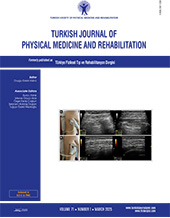Comparison of extracorporeal shock wave therapy and manual therapy on active trigger points of the sternocleidomastoid muscle in cervicogenic headache: A randomized controlled trial
2 Department of Ultrasound, Weifang People's Hospital, Weifang, Shandong, China
3 Department of Neurology, Weifang People's Hospital, Weifang, Shandong, China DOI : 10.5606/tftrd.2024.13994 Objectives: The study aimed to investigate the effect of extracorporeal shock wave therapy (ESWT) and manual therapy (MT) on active trigger points of the sternocleidomastoid muscle (SCM) in patients with cervicogenic headache (CEH).
Patients and methods: A total of 42 patients were included (27 females, 15 males; mean age: 33.2±7.7 years; range, 18 to 45 years) in the randomized controlled trial between March 2022 and December 2022. The patients were randomly divided into the ESWT group (n=21) and the MT group (n=21). Each group received therapy once a week for four weeks. The primary outcome measure was the Visual Analog Scale (VAS), and secondary outcome measures were pressure pain threshold (PPT), Neck Disability Index (NDI), and stiffness (shear elastic modulus) of the SCM measured at baseline, postintervention, and four weeks after treatment.
Results: One patient from the ESWT group was lost to follow-up. The missing data were imputed for intention-to-treat analysis. Significant decreases of VAS, NDI, and shear elastic modulus of SCM were found at postintervention and four weeks after treatment in both groups (p<0.01). The PPT scores markedly increased over time compared to baseline in both groups (p<0.01). The repeated measures of analysis of variance revealed a significant time effect (p<0.001) in each outcome variable for both groups. There were no significant differences between the two groups in VAS, PPT, NDI, and the stiffness of SCM at each time point.
Conclusion: Extracorporeal shock wave therapy and MT were equally effective in pain relief, functional recovery, and reduction of muscle stiffness. Extracorporeal shock wave therapy may be used as an alternative treatment method for CEH patients with active MTPs of the SCM.
Keywords : Cervicogenic headache, extracorporeal shock wave therapy, manual therapy, trigger points

















